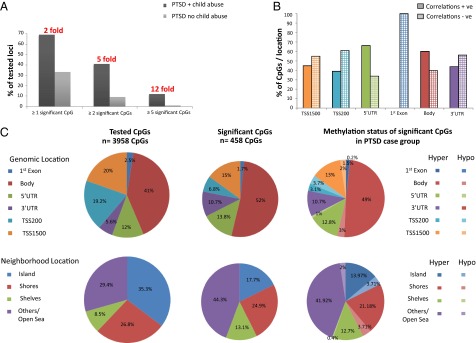Fig. 2.

Influence of child abuse on DNA methylation in peripheral blood in PTSD. (A) DNA methylation differences are more frequent in PTSD with child abuse. The bar graph shows the percentage of transcripts differentially regulated in the two respective group comparisons having one or more, two or more, or five or more differentially methylated CpGs in the locus. DNA methylation changes underlying the observed gene expression differences were 2- to 12-fold higher in the PTSD with child abuse group compared with the PTSD with no child abuse group. (B) Correlations of DNA methylation with gene expression. The bar graph shows the percent of CpGs with positive vs. negative correlations with gene expression of the closest transcript in the whole sample stratified by location with respect to the regulated gene. Inverse correlations close to the transcription start sites and an increasing proportion of positive correlations in proximal and distal regulatory sites were observed. (C) Distribution of the tested (left panels) and significant (middle panels) CpGs and direction of methylation across all differentially methylated CpGs in both groups. The right panels denote the relative distributions of all tested and significant CpG sites with respect to the closest gene and the CpG islands and the directions of methylation differences of the significant CpGs. Of the significant CpGs, 90% were hypermethylated and 10% were hypomethylated in the PTSD case group with respect to the controls.
